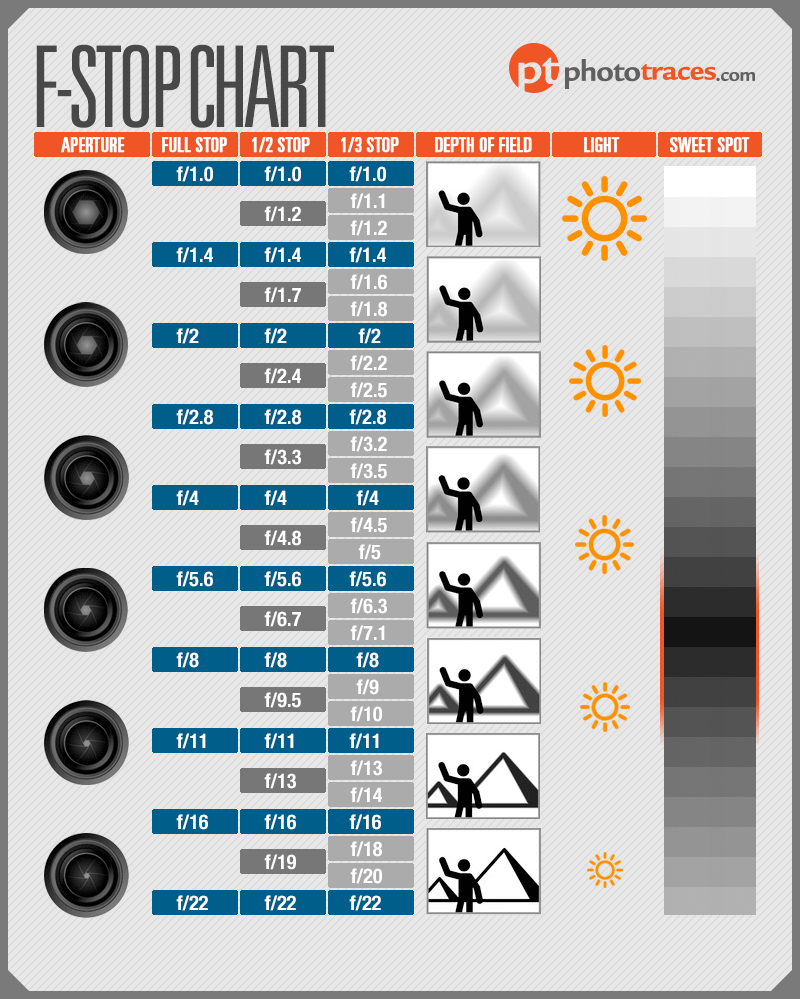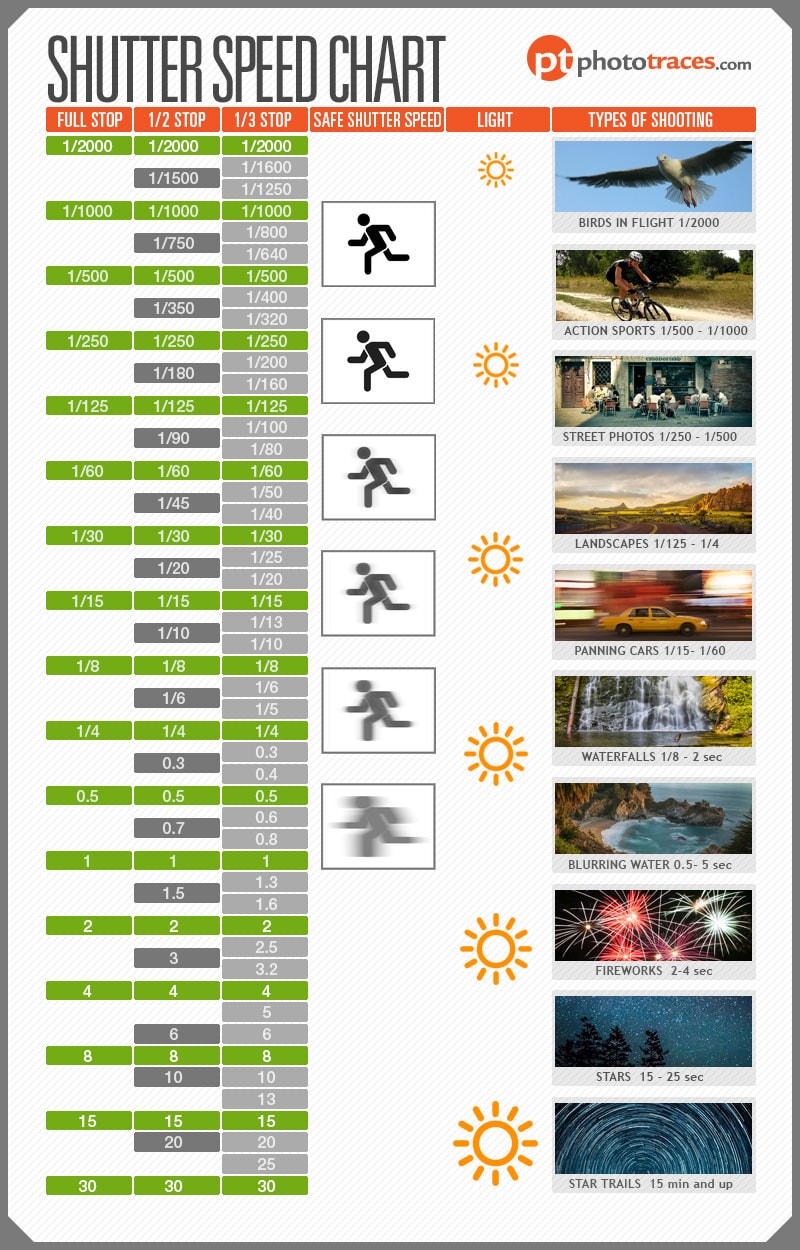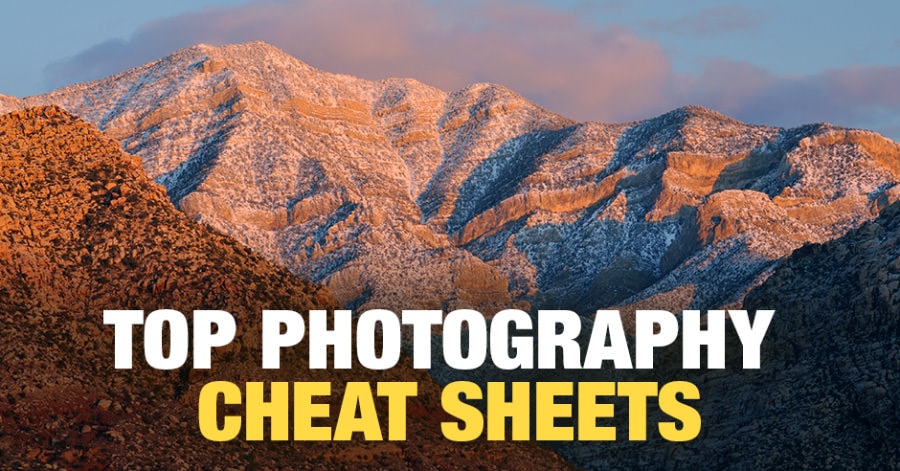
A photography cheat sheet is a graphical representation of one of the concepts of photography.
As a visual person myself, I find that visual learning is the most effective method of absorbing and retaining complex information.
Photography Cheat Sheets
Below is the collection of cheat sheets and infographics I use on my website to accompany written articles and tutorials.
Feel free to download the cheat sheets, printing them out and using them when you are out exploring and shooting.
1. F-Stop Chart Cheat Sheet
An F-Stop Chart cheat sheet visually demonstrates different aspects of the most fundamental concept of modern photography – aperture.
The cheat sheet also highlights the aperture relationships with F-stop, lens design, depth of field, and light transmission.
This photography cheat sheet is a practical tool designed to help photographers at all levels unlock the creative potential of aperture settings. Whether you’re a beginner seeking to grasp the basics or an experienced photographer aiming to fine-tune your skills, the F-Stop
For more info, please check the original tutorial where F-Stop Chart was initially published: F-Stop Chart – Aperture in Photography CheatSheet
Download Photography Cheat Sheet PDF Document (120Kb)
2. Shutter Speed Chart Cheat Sheet
As you’re likely aware, Shutter Speed plays a pivotal role in the exposure triangle, working in tandem with aperture and ISO to regulate the amount of light that reaches the camera sensor and ensure proper exposure.
Yet, Shutter Speed encompasses an even more vital function: the control of motion in your photographs.
Photography, by its nature, is a medium that captures static moments, and conveying motion within still images may seem like a paradox. However, what we can accomplish is the creation of the illusion of motion, allowing viewers to immerse themselves in the fast-paced action or savor the dreamy, slow-motion feel.
By employing various Shutter Speed settings, we have the power to craft visual effects that seamlessly blend the realms of reality and illusion, adding depth and dynamism to our photographs.
To learn more, please check the original article where Shutter Speed Chart was initially published: Shutter Speed Chart – Controlling Motion
Download Shutter Speed Photography Cheat Sheet PDF (200Kb)
3. ISO Chart – ISO Cheat Sheet
The ISO Chart serves as a comprehensive guide for photographers seeking to master the complexities of ISO in digital photography.
Understanding Stops: The ISO Chart cheat sheet effectively illustrates how stops work, offering a clear view of how adjustments in ISO values impact image brightness. By visualizing these increments, photographers can easily grasp the concept of ISO stops and their practical application.
Taming Digital Noise: Digital noise can be a formidable adversary when working with high ISO settings. The ISO Chart sheds light on the relationship between ISO and digital noise. As ISO values increase, the chart showcases how digital noise gradually creeps into the image, helping photographers make informed choices about balancing ISO and image quality.
Exposure Control: ISO plays a pivotal role in controlling exposure. The ISO Chart makes this relationship tangible, demonstrating that higher ISO values result in brighter photos.
Scenarios and Recommendations: For photographers seeking specific ISO recommendations, the ISO Chart provides a handy reference. It advises ISO values for different scenarios, such as landscapes, birds in flight, and astrophotography. For instance, when capturing landscapes, ISO values between 50 and 100 are recommended. If you’re chasing the birds in flight, consider ISO settings in the range of 400 to 800. When venturing into the world of astrophotography, ISO values between 1600 and 3200 are suggested.
These practical guidelines help photographers make well-informed decisions while setting their ISO levels.
To learn more, please check the original article where ISO Chart was initially published: Shutter ISO Chart – Cheat Sheet for Controlling Exposure
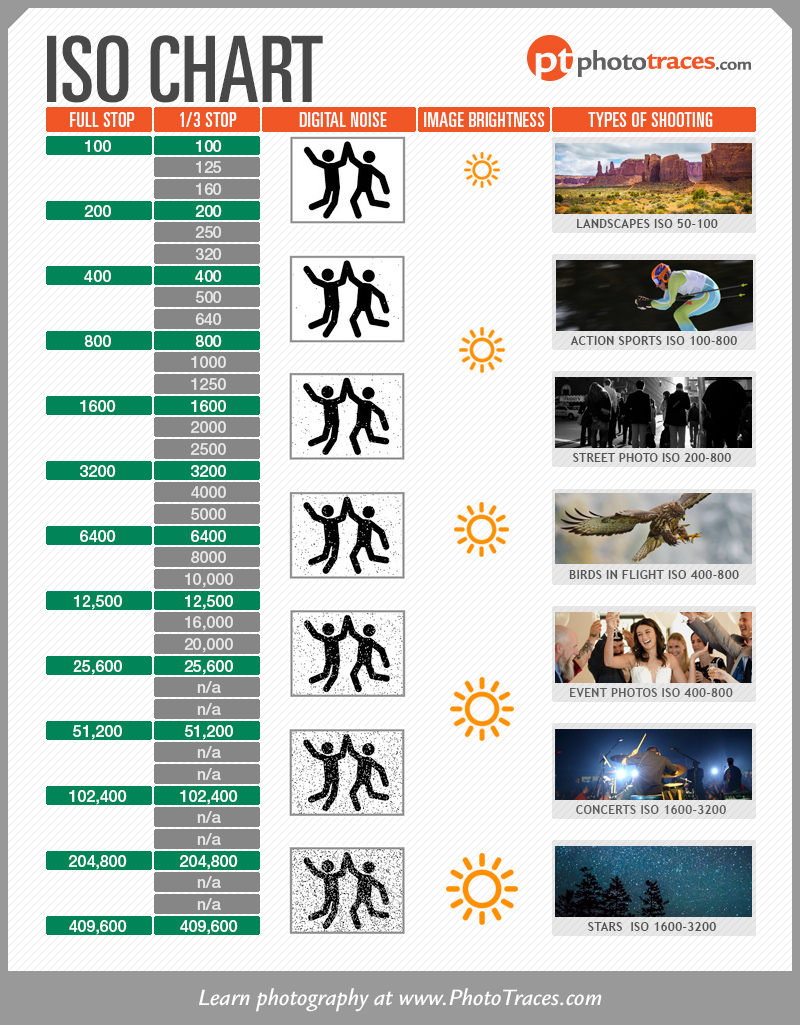
Download ISO Chart Photography Cheat Sheet PDF (200Kb)
4. Exposure Triangle Infographic
The exposure triangle is a fundamental concept in photography, illustrating the interconnectedness of three key components: Aperture, Shutter Speed, and ISO. Each of these parameters plays a critical role in capturing available light and producing well-exposed images, and they bring their distinct functionalities to the table.
At the same time, each parameter (Aperture, Shutter Speed, ISO) carries its unique functionalities.
Aperture control Depth of Field (DoF)
Shutter Speed controls the motion in our photographs.
ISO is responsible for the amount of digital noise in images we capture.
Understanding these components and their functionalities is essential for any photographer, as they form the basis for achieving well-exposed and visually striking images. Whether you’re striving for breathtaking landscapes, captivating portraits, or dynamic action shots, mastering the exposure triangle is your path to photographic excellence.
In-depth tutorial: Exposure Triangle Explained
![Photography Cheat Sheet Selection [Top Infographics] 1](https://phototraces.b-cdn.net/wp-content/uploads/2020/07/id_Exposure_Triangle_Infographic.png)
5. Top Lightroom Keyboard Shortcuts Cheat Sheet
Below is the cheat sheet with a list of Lightroom keyboard shortcuts that are most important for my editing workflow and indicate how I use Lightroom.
For more detail on Lightroom shortcuts, check the following article: Top Lightroom Keyboard Shortcuts
![Photography Cheat Sheet Selection [Top Infographics] 2](https://phototraces.b-cdn.net/wp-content/uploads/2020/09/info_Lightroom_Keyboard_Shortcuts_Top_25_900px.png)
Download Lightroom Keyboard Shortcuts Cheat Sheet PDF (150Kb)
6. Neutral Density (ND) Filter Chart
Among landscape photographers, Neutral Density (ND) Filters are highly regarded and widely used. These unassuming filters play a crucial role in refining the art of capturing stunning landscapes.
ND Filters are tools used to control the intensity of light before it reaches the camera sensor. This simple action has a significant impact on the resulting photographs.
One primary function of ND Filters is to provide control. They allow photographers to control motion in their images, creating captivating long exposure shots that can appear dream-like. Additionally, these filters offer greater control over the Depth of Field (DoF), enhancing the interplay between foreground and background elements.
Photographers often rely on the ND Filter Chart to make working with ND Filters easier. This tool helps determine the appropriate Shutter Speed values when using ND Filters of different strengths, simplifying the process.
For example, when using a powerful 4-stop ND Filter, photographers need to adjust the shutter speed, transitioning from a fast 1/250s to a slower 1/15s. The ND Filter Chart streamlines these calculations, ensuring precise results.
For a deeper exploration of ND Filters and a comprehensive ND Filter Chart, please refer to the original article: “What is an ND Filter?“. This resource provides in-depth insights into applications and techniques to enhance your landscape photography.
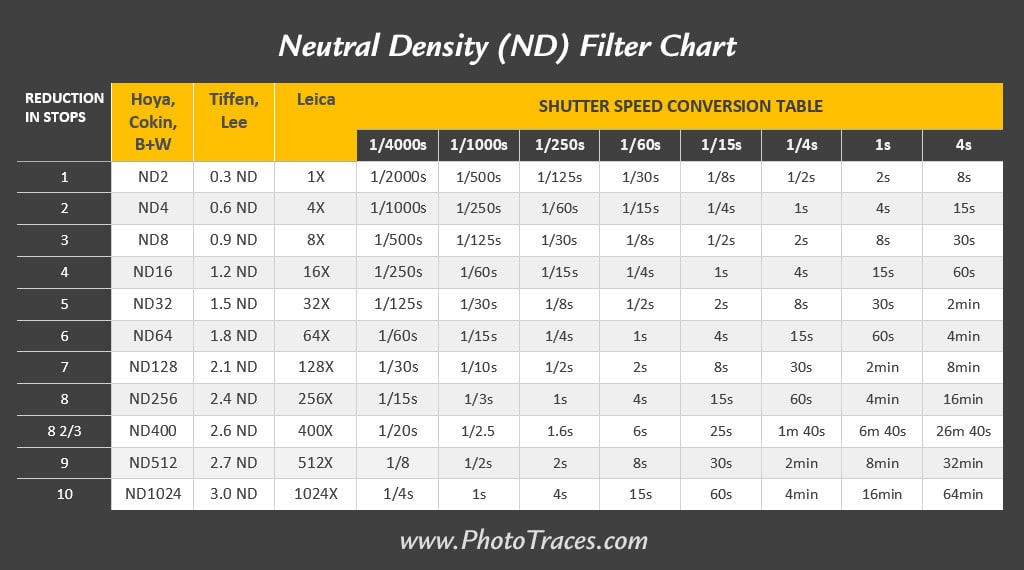
7. Full Frame Lens on APS-C Camera vs APS-C Lens on Full Frame Camera Cheat Sheet
What happens when you attach a Full-Frame lens to an APS-C crop sensor camera? And what result should you expect when you use an APS-C lens on a Full Frame camera. The right answers are not as apparent as you think.
The Full Frame vs APS-C infographic helps us understand what happens with the Circle of Projection when mixing Full Frame and APS-C lenses and cameras.
It is easy to see, looking at the infographic, that the Circle of Projection of any given lens stays constant no matter what camera you use. What changes is the size of the sensor behind the lens.
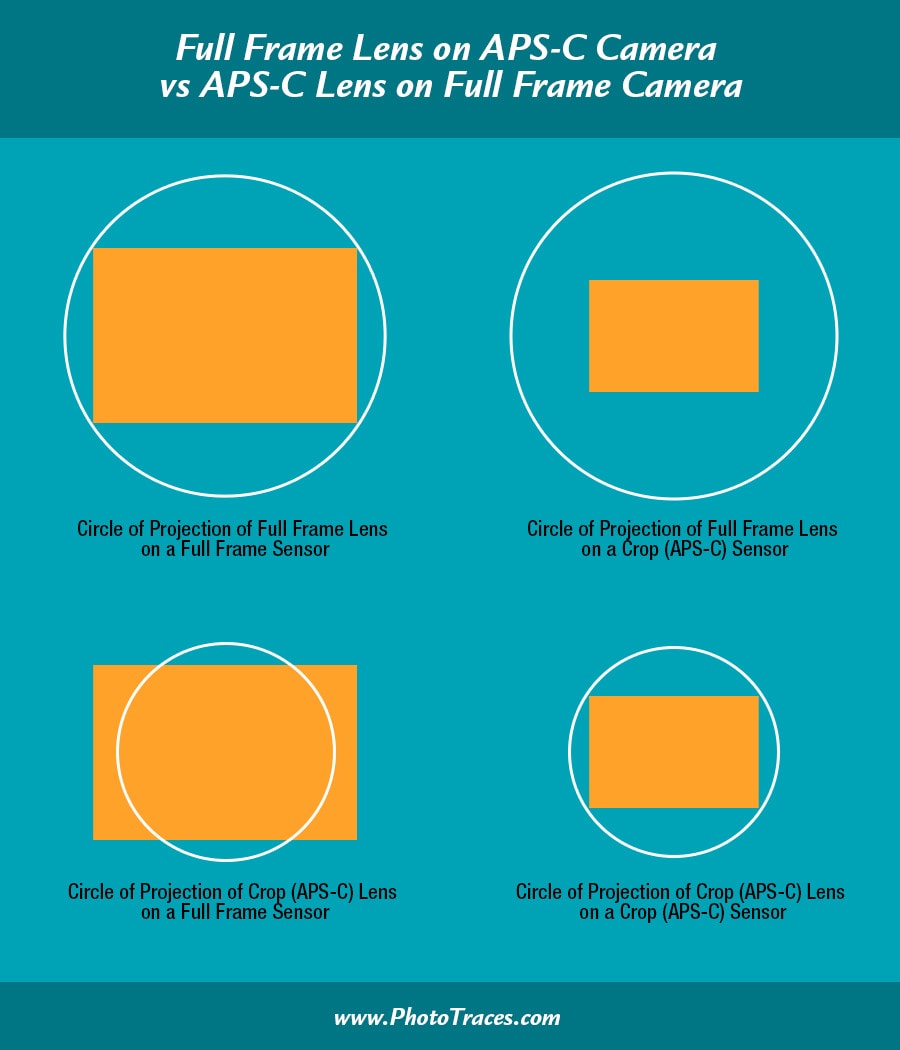
8. Size of Camera Sensor and Field of View Cheat Sheet
The visual guide provided below is designed to help illustrate the relationship between a digital camera’s sensor size and the lens field of view.
It’s essential to understand that the size of the camera sensor does not impact the way a lens transmits light. Instead, it significantly influences the field of view that your camera captures. In simple terms, a smaller sensor equates to a narrower field of view.
For example, consider a 50mm f1.8 lens mounted on full-frame, APS-C, and Micro Four Thirds cameras. Regardless of the sensor size, this lens transmits light at the same rate, maintaining its fundamental characteristics. However, the key difference lies in the field of view each sensor provides.
When you attach the 50mm lens to an APS-C camera, you’ll notice that the field of view narrows, effectively multiplying the lens’s focal length by a factor of 1.5. In practical terms, it behaves as if it were a 75mm lens.
Moving to a Micro Four Thirds camera, the field of view further reduces, this time by a factor of 2. Consequently, the same 50mm lens on a Micro Four Thirds camera replicates the field of view of a 100mm lens.
If you’re interested in exploring this concept further, consider delving into the comprehensive tutorial titled “Full Frame Lens on APS-C vs APS-C Lens on Full Frame Explained.” This resource will provide an even more detailed insight into this topic.
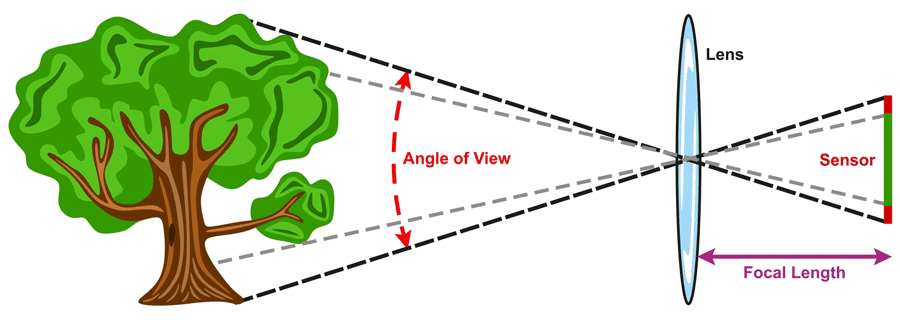
9. Golden Hour in Photography Cheat Sheet
We are well aware that sunsets and sunrises offer ideal moments for capturing breathtaking landscapes and seascapes. However, the intriguing question arises: why does light undergo such a remarkable transformation from midday to evening and from morning to noon?
The Golden Hour Infographic provides an insightful explanation, revealing that during the evening or morning, light must traverse distances ten times greater through the Earth’s atmosphere compared to midday. Once we grasp that the Earth’s atmosphere functions as a colossal natural diffuser, the gentle, golden quality of the light during the Golden Hour becomes evident.
Original article: Best Time to Take Pictures Outside
![Photography Cheat Sheet Selection [Top Infographics] 3](https://phototraces.b-cdn.net/wp-content/uploads/2020/07/info_Golden_Hour_for_Landscape_Travel_Photography.png)
Download the Golden Hour Cheat Sheet PDF (170Kb)
10. Body of Light for Landscape Photographers
If you are a landscape photographer, you need to understand when is the best time to take photos outdoors.
The Anatomy of Light cheat sheet does just that.
The Golden Hour starts around 40min before sunset. It continues for another 20min or so after the sun dips under the horizon.
And later, the Golden Hour transforms into Blue Hour in with the light becomes even softer and cooler.
Together the Golden Hour and the Blue Hour produce the most favorable time for landscape photography, also known as Magic Hours.
Original article: Best Time to Take Pictures Outside: In-Depth Gude
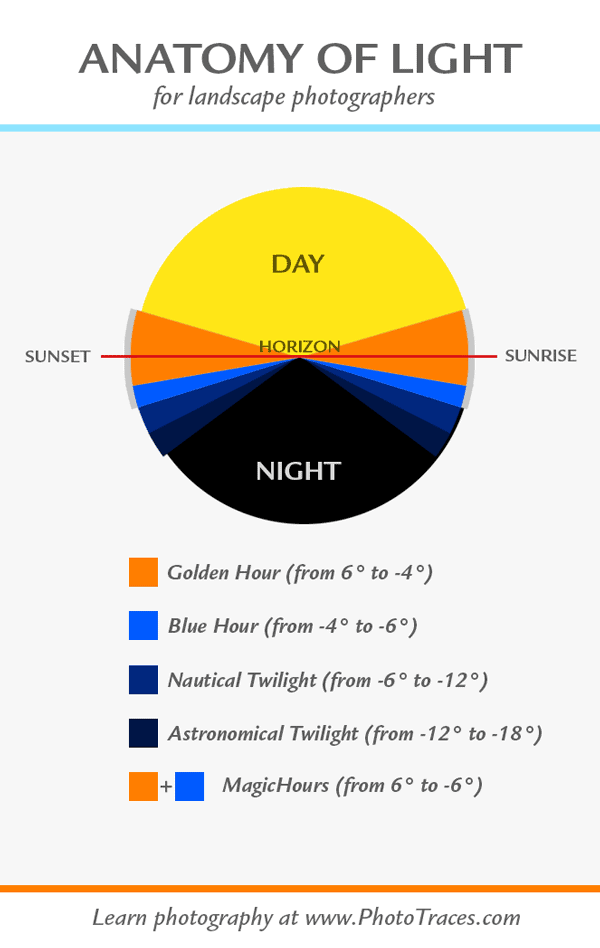
11. Standard Photo Print Sizes
The Standard Photo Sizes cheat sheet gives all the necessary information when you are planning to print your photos.
The infographic lists the most common photo print sizes, their aspect ratios, metric dimensions, and even the minimum number of pixels required to achieve the best quality of prints.
Originally appeared here: Standard Photo Sizes
12. Hyperfocal Distance – Photography Cheat Sheet
Hyperfocal Distance infographic illustrates how to maximize Depth of Field (DoF) for landscape photographers
![Photography Cheat Sheet Selection [Top Infographics] 5](https://phototraces.b-cdn.net/wp-content/uploads/2020/07/info_Hyperfocal_Distance_Infographic_1.png)
13. Big Sur Photo Location Guide Cheat Sheet
The Pacific coastal drive from Los Angeles to San Francisco is one of my favorite experiences as a photographer. The journey is such a fruitful driving trip that I had to complete it 3 or 4 times before I could hit all spots worth exploring and capturing.
And of course, the Big Sur part of the drive is a crown jewel of the entire drivel. It stretches over 200-250km and offers the most exciting and visually stunning locations.
I selected my top 12 favorite locations along the drive and placed them into a cheat sheet infographic.
Check the original article: Big Sur California – Places to See and Photograph
![Photography Cheat Sheet Selection [Top Infographics] 6](https://phototraces.b-cdn.net/wp-content/uploads/2020/07/id_Big_Sur_Infographic-1-scaled.jpg)
14. Lightroom Export Settings for Instagram
From the following article: Lightroom Export Settings for Instagram
![Photography Cheat Sheet Selection [Top Infographics] 7](https://phototraces.b-cdn.net/wp-content/uploads/2020/08/info_Lightroom_Export_Settings_for_Instagram.png)
15. Paper Sizes
There are two broad groups of photo dimensions. You may be familiar with one of them from using inkjet or laser printers; these sizes are referred to as A0, A1, A4, etc, and are part of a system offered by the International Standard Organization (ISO).
![Photography Cheat Sheet Selection [Top Infographics] 8](https://phototraces.b-cdn.net/wp-content/uploads/2020/02/fi_Photo_Sizes_A_Series_Format_Sizes.jpg)
![Photography Cheat Sheet Selection [Top Infographics] 9](https://phototraces.b-cdn.net/wp-content/uploads/2020/02/fi_Photo_Sizes_A_Series_Paper_Sizes.jpg)
And here are the dimensions used when printing photos. They are the widths and heights used by photo labs pretty much everywhere, and they are what you get if you go to purchase prints. These dimensions include:
![Photography Cheat Sheet Selection [Top Infographics] 4](https://phototraces.b-cdn.net/wp-content/uploads/2020/02/fi_Photo_Sizes_Standard_Photo_Print_Sizes_and_Resolution.jpg)
16. Camera Lens Hood – Photography Cheat Sheet
A camera lens hood is an essential accessory for photographers. It helps to protect the lens from physical damage, and also to block unwanted direct stray light. This photography cheat sheet an overview of the different types of camera lens hoods available and the benefits of each. This infographic provides an overview of what a camera lens hood is, how it works, and why you should use one.
From the following article: Camera Lens Hood
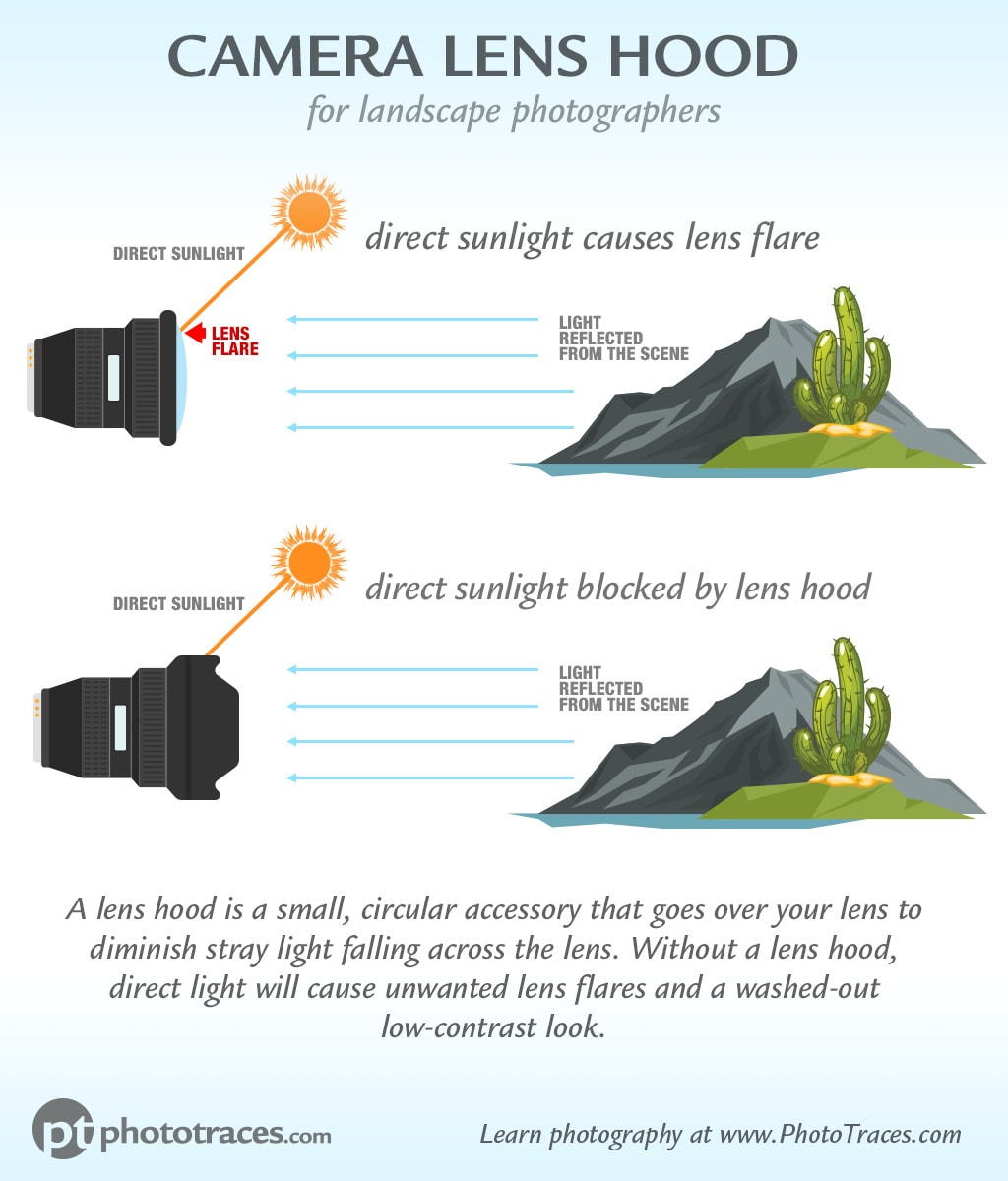
17. Histogram in Photography Cheat Sheet
The histogram in photography infographic is a practical and visual learning tool that simplifies the understanding of histograms. It offers guidance on how to read histograms effectively and provides tips for improving exposure and tonal balance in your images. With the help of this photography cheat sheet, you can enhance your photography and editing skills, leading to better-exposed and more visually appealing photographs.
From the following article: Histogram in Photography & How to Read a Histogram
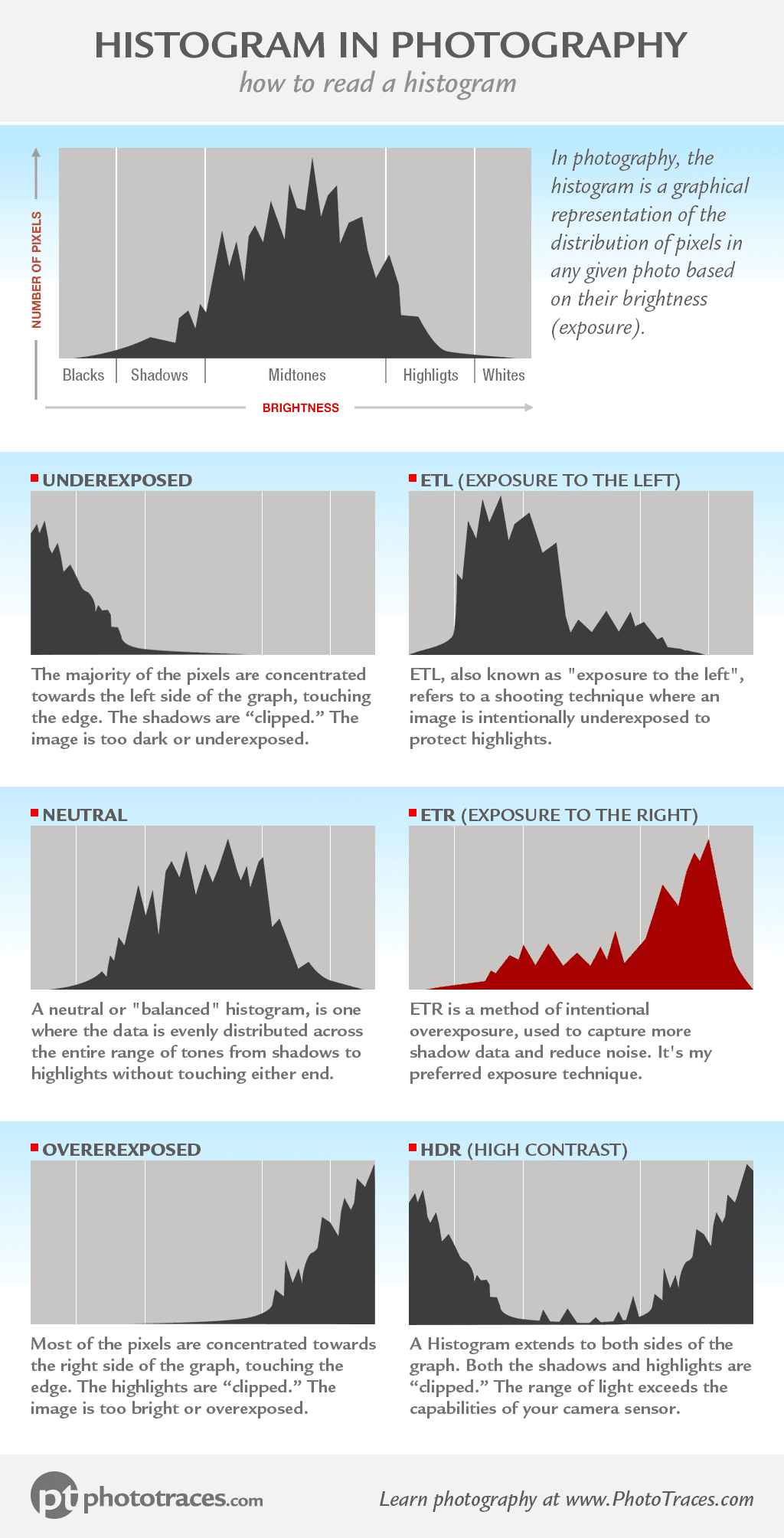
Photography Cheat Sheets | Conclusion
Whether you’re a beginner or a seasoned photographer, cheat sheets are a great way to keep all of your photography knowledge in one place. By having a go-to reference, you can quickly and easily find the information you need to take your photography to the next level.


